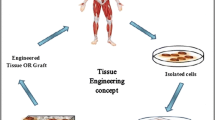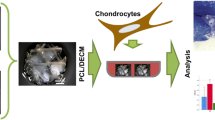Abstract
Background:
Reconstruction of large eyelid defects remains challenging due to the lack of suitable eyelid tarsus tissue substitutes. We aimed to evaluate a novel bioengineered chitosan scaffold for use as an eyelid tarsus substitute.
Methods:
Three-dimensional macroporous chitosan hydrogel scaffold were produced via cryogelation with specific biomechanical properties designed to directly match characteristics of native eyelid tarsus tissue. Scaffolds were characterized by confocal microscopy and tensile mechanical testing. To optimise biocompatibility, human eyelid skin fibroblasts were cultured from biopsy-sized samples of fresh eyelid skin. Immunological and gene expression analysis including specific fibroblast-specific markers were used to determine the rate of fibroblast de-differentiation in vitro and characterize cells cultured. Eyelid skin fibroblasts were then cultured over the chitosan scaffolds and the resultant adhesion and growth of cells were characterized using immunocytochemical staining.
Results:
The chitosan scaffolds were shown to support the attachment and proliferation of NIH 3T3 mouse fibroblasts and human orbital skin fibroblasts in vitro. Our novel bioengineered chitosan scaffold has demonstrated biomechanical compatibility and has the ability to support human eyelid skin fibroblast growth and proliferation.
Conclusions:
This bioengineered tissue has the potential to be used as a tarsus substitute during eyelid reconstruction, offering the opportunity to pre-seed the patient’s own cells and represents a truly personalised approach to tissue engineering.








Similar content being viewed by others
References
Fransen M, Karahalios A, Sharma N, English DR, Giles GG, Sinclair RD. Non-melanoma skin cancer in Australia. Med J Aust. 2012;197:565–8.
DiFrancesco LM, Codner MA, McCord CD. Upper eyelid reconstruction. Plast Reconstr Surg. 2004;114:98e–107.
Milz S, Neufang J, Higashiyama I, Putz R, Benjamin M. An immunohistochemical study of the extracellular matrix of the tarsal plate in the upper eyelid in human beings. J Anat. 2005;206:37–45.
Ito O, Suzuki S, Park S, Kawazoe T, Sato M, Saso Y, et al. Eyelid reconstruction using a hard palate mucoperiosteal graft combined with a V-Y subcutaneously pedicled flap. Br J Plast Surg. 2001;54:106–11.
Kamiya H, Kitajima Y. Successful use of preserved sclera of eyelid reconstruction. Eur J Dermatol. 2003;13:267–71.
Zhou J, Peng SW, Wang YY, Zheng SB, Wang Y, Chen GQ. The use of poly(3-hydroxybutyrate-co-3-hydroxyhexanoate) scaffolds for tarsal repair in eyelid reconstruction in the rat. Biomaterials. 2010;31:7512–8.
Gao Q, Hu B, Ning Q, Ye C, Xie J, Ye J, et al. A primary study of poly(propylene fumarate)-2-hydroxyethyl methacrylate copolymer scaffolds for tarsal plate repair and reconstruction in rabbit eyelids. J Mater Chem B. 2015;3:4052–62.
Sun MT, Pham DT, O'Connor AJ, Wood J, Casson R, Selva D, et al. The biomechanics of eyelid tarsus tissue. J Biomech. 2015;48:3455–9.
Adekogbe I, Ghanem A. Fabrication and characterization of DTBP-crosslinked chitosan scaffolds for skin tissue engineering. Biomaterials. 2005;26:7241–50.
Berger J, Reist M, Mayer JM, Felt O, Gurny R. Structure and interactions in chitosan hydrogels formed by complexation or aggregation for biomedical applications. Eur J Pharm Biopharm. 2004;57:35–52.
Koyano T, Minoura N, Nagura M, Kobayashi K. Attachment and growth of cultured fibroblast cells on PVA/chitosan-blended hydrogels. J Biomed Mater Res. 1998;39:486–90.
Di Martino A, Sittinger M, Risbud MV. Chitosan: a versatile biopolymer for orthopaedic tissue-engineering. Biomaterials. 2005;26:5983–90.
Madihally SV, Matthew HW. Porous chitosan scaffolds for tissue engineering. Biomaterials. 1999;20:1133–42.
Henderson TMA, Ladewig K, Haylock DN, McLean KM, O’Connor AJ. Cryogels for biomedical applications. J Mater Chem B. 2013;1:2682–95.
Biswas D, Tran P, Tallon C, O’Connor AJ. Combining mechanical foaming and thermally induced phase separation to generate chitosan scaffolds for soft tissue engineering. J Biomater Sci Polym Ed. 2017;28:207–26.
Cao Y, Davidson MR, O’Connor AJ, Stevens GW, Cooper-White JJ. Architecture control of three-dimensional polymeric scaffolds for soft tissue engineering. I. Establishment and validation of numerical models. J Biomed Mater Res A. 2004;71:81–9.
Cao Y, Mitchell G, Messina A, Price L, Thompson E, Penington A, et al. The influence of architecture on degradation and tissue ingrowth into three-dimensional poly(lactic-co-glycolic acid) scaffolds in vitro and in vivo. Biomaterials. 2006;27:2854–64.
Hsieh CY, Tsai SP, Ho MH, Wang DM, Liu CE, Hsieh CH, et al. Analysis of freeze-gelation and cross-linking processes for preparing porous chitosan scaffolds. Carbohydr Polym. 2007;67:124–32.
Schindelin J, Arganda-Carreras I, Frise E, et al. Fiji: an open-source platform for biological-image analysis. Nature meth. 2012;9:676–82.
Chandy T, Sharma CP. Chitosan—as a biomaterial. Biomater Artif Cells Artif Organs. 1990;18:1–24.
Croisier F, Jérôme C. Chitosan-based biomaterials for tissue engineering. Eur Polym J. 2013;49:780–92.
Waibel KH, Haney B, Moore M, Whisman B, Gomez R. Safety of chitosan bandages in shellfish allergic patients. Mil Med. 2011;176:1153–6.
VandeVord PJ, Matthew HW, DeSilva SP, Mayton L, Wu B, Wooley PH. Evaluation of the biocompatibility of a chitosan scaffold in mice. J Biomed Mater Res. 2002;59:585–90.
Bogatkevich GS, Tourkina E, Silver RM, Ludwicka-Bradley A. Thrombin differentiates normal lung fibroblasts to a myofibroblast phenotype via the proteolytically activated receptor-1 and a protein kinase C-dependent pathway. J Biol Chem. 2001;276:45184–92.
Ludwicka A, Trojanowska M, Smith EA, Baumann M, Strange C, Korn JH, et al. Growth and characterization of fibroblasts obtained from bronchoalveolar lavage of patients with scleroderma. J Rheumatol. 1992;19:1716–23.
Nolte SV, Xu W, Rennekampff HO, Rodemann HP. Diversity of fibroblasts—a review on implications for skin tissue engineering. Cells Tissues Organs. 2008;187:165–76.
Rinn JL, Bondre C, Gladstone HB, Brown PO, Chang HY. Anatomic demarcation by positional variation in fibroblast gene expression programs. PLoS Genet. 2006;2:e119.
Li H, Roos JC, Rose GE, Bailly M, Ezra DG. Eyelid and sternum fibroblasts differ in their contraction potential and responses to inflammatory cytokines. Plast Reconstr Surg Glob Open. 2015;3:e448.
Acknowledgements
Dr Sun is supported by a University of Adelaide Early Career Fellowship. This study was partly funded by a New Investigator Grant from the Ophthalmic Institute of Australia and an AVANT Doctor in Training Grant.
Author information
Authors and Affiliations
Corresponding author
Ethics declarations
Conflict of interest
The authors declare that they have no conflict of interest.
Ethical statement
The study protocol was approved by the institutional review board of the Royal Adelaide Hospital (R20131001 HREC/13/RAH/412).
Additional information
Publisher's Note
Springer Nature remains neutral with regard to jurisdictional claims in published maps and institutional affiliations.
Rights and permissions
About this article
Cite this article
Sun, M.T., O’Connor, A.J., Milne, I. et al. Development of Macroporous Chitosan Scaffolds for Eyelid Tarsus Tissue Engineering. Tissue Eng Regen Med 16, 595–604 (2019). https://doi.org/10.1007/s13770-019-00201-2
Received:
Revised:
Accepted:
Published:
Issue Date:
DOI: https://doi.org/10.1007/s13770-019-00201-2




